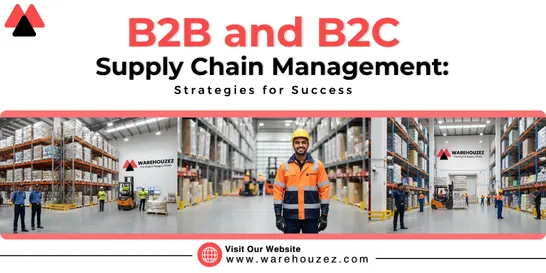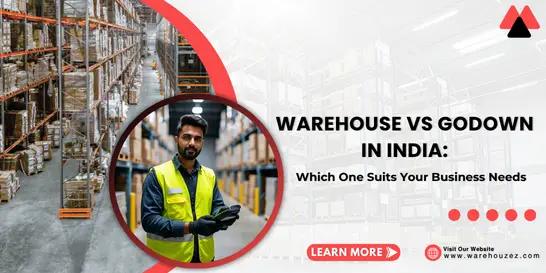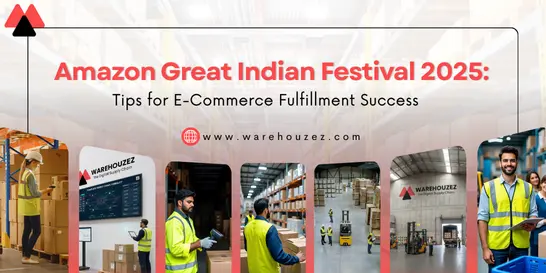5 Warehousing Features That Make or Break B2B & B2C Customer Experience
5 Warehousing Features That Make or Break B2B & B2C Customer Experience
“What’s delivered fast is always remembered longer.” In today’s fast-paced world, speed, accuracy, and visibility define a customer’s experience. Whether it's a business ordering spare parts or a customer shopping online, behind every smooth delivery is a smart warehouse system at work.
B2B and B2C fulfillment models may look different, but they both rely heavily on warehousing. The efficiency of these warehouses directly impacts brand reputation, customer satisfaction, and repeat business.
In this blog post, we’ll explore how warehousing plays a major role in B2B and B2C success, and highlight the five essential features that can either delight your customers or drive them away. So, let's get started!
Why Effective Warehousing Is Essential for B2B and B2C Success
Warehousing services are no longer just about storage. Today, they serve as the backbone of every modern supply chain. For B2B and B2C operations, warehouse performance impacts:
- Inventory accuracy
- Cost-efficiency
- Delivery speed
- Customer satisfaction
In B2B warehousing, a delayed delivery can disrupt manufacturing timelines or retail distribution. In B2C warehousing, one wrong item or late order can cause poor
reviews and lost sales.
An effective warehouse ensures optimized inventory levels, smooth order processing, and zero errors. This boosts trust and loyalty among both business buyers and individual customers.
According to a survey conducted by McKinsey, over 70% of consumers expect accurate and fast delivery. The pressure is on, and your warehouse needs to keep up.
B2B vs. B2C Warehouses: What’s the Difference
While both serve as storage and distribution hubs, B2B and B2C warehouses are designed to meet very different needs.
Let’s break it down:
1. Order Size and Volume:
B2B warehouses basically handle large, bulk shipments to wholesalers, retailers, or distributors. Orders are fewer but contain more units.
B2C warehouses handle a high volume of smaller, individual orders placed by online customers everyday.
2. Packaging Needs:
In B2B fulfillment, packaging is focused on efficiency and safety, typically using pallets or bulk containers.
In B2C fulfillment, packaging must be presentable, secure, and often customized to enhance customer experience.
3. Shipping Timelines:
B2B shipments are usually scheduled beforehand, which allows flexibility in timing.
B2C orders are time-sensitive, with customers expecting same-day or next-day shipping options.
4. Returns and Reverse Logistics:
Returns in B2B are rare and require strict, well-optimized processes.
In B2C, returns are common and must be fast, hassle-free, and customer-friendly, making a strong reverse logistics system essential.
5. Technology and Software Integration:
B2B fulfillment workflows integrate with ERP, IMS, and WMS software solutions.
B2C fulfillment needs automated order updates, real-time tracking, and smooth e-commerce platform connectivity.
Understanding these differences helps businesses choose the right 3PL warehousing partner or configure their internal operations better.
5 Warehousing Features That Make or Break B2B & B2C Customer Experience
Let’s now explore the five critical features that influence your warehousing success. Whether you run a B2B or B2C brand, these features impact how your customers perceive your service.
1. Real-Time Inventory Visibility
Having a real-time view of your stock is crucial for both B2B and B2C fulfillment.
For B2B: Accurate stock levels help avoid understocking and delayed B2B orders.
For B2C: It ensures items shown as "in stock" online are truly available.
WMS software plays a key role here. With features like demand forecasting and live stock/order tracking, it ensures businesses never miss a sale due to inaccurate data.
2. Speed and Accuracy in Order Processing
Speed alone isn’t enough—accuracy is just as important.
B2B clients need their large orders delivered on time and without error.
B2C customers often expect same-day or next-day delivery with 100% perfect order accuracy.
Warehouses that use automation, barcode scanning, and optimized picking systems perform better on both fronts.
3. Scalable Storage and Operations
Peak seasons, new product launches, or market expansions, your storage needs won’t stay constant.
B2B warehouses often need space for high-volume inventory.
B2C warehouses must handle order spikes, especially during sales.
Scalable warehouse services give you the flexibility to grow without disruptions. On-demand warehousing is one such solution.
4. Hassle-Free Returns Management
Returns are part of the modern shopping experience, especially in B2C.
A well-optimized reverse logistics process helps retain customer trust.
In B2B, managing defective returns or restocking efficiently keeps businesses satisfied.
Warehouses with clear return protocols and automated tracking offer a smoother experience for both ends.
5. Seamless Integration with Technology
From WMS software to last-mile tracking, the modern warehouse must be tech-enabled.
APIs, dashboards, and ERP/IMS/WMS integrations help B2B businesses manage their supply chains better.
For B2C brands, tech enables order tracking, SMS alerts, and real-time updates for end customers.
Smart, tech-driven warehousing isn't a trend anymore, it's indeed a requirement.
The Role of Technology in Delivering Fulfillment Excellence
Technology drives accuracy, speed, and visibility. Here's how it enhances customer experience:
AI and Data Analytics: Predict demand, optimize space, and reduce waste.
Automation and Robotics: Speeds up sorting and picking in high-volume B2C environments.
Warehouse Management Systems (WMS): Manages inventory, order picking, and warehouse layout efficiently.
A B2B fulfillment partner that uses modern tech can offer detailed performance reports, while a B2C partner can offer app-based tracking to end-users. Both create smoother experiences.
How the Right 3PL Partner Makes a Difference
Choosing an experienced, well-suited Third-Party Logistics (3PL) provider is certainly crucial.
A good 3PL partner offers:
- A network of B2B and B2C warehouses across key locations
- Scalable and flexible storage options
- Use of WMS software for real-time visibility
- Tailored B2B fulfillment and B2C fulfillment strategies
- Expertise in reverse logistics
Example: A fashion and lifestyle brand using a 3PL partner for B2C warehousing saw a 30% reduction in return time and a 20% boost in positive customer reviews.
With the right partner, brands can focus on growth while logistics run smoothly in the background.
Wrapping Up
Today, warehousing is no longer just about storing goods, it’s about shaping the customer journey.
From large B2B clients to everyday B2C consumers, everyone expects fast, accurate, and visible deliveries. A warehouse that ticks the boxes on technology, speed, accuracy, and returns can uplift customer satisfaction across all segments.
As brands scale, investing in the smart warehousing services, and choosing partners with the right B2B and B2C warehousing expertise—is the smartest move toward long-term success.



